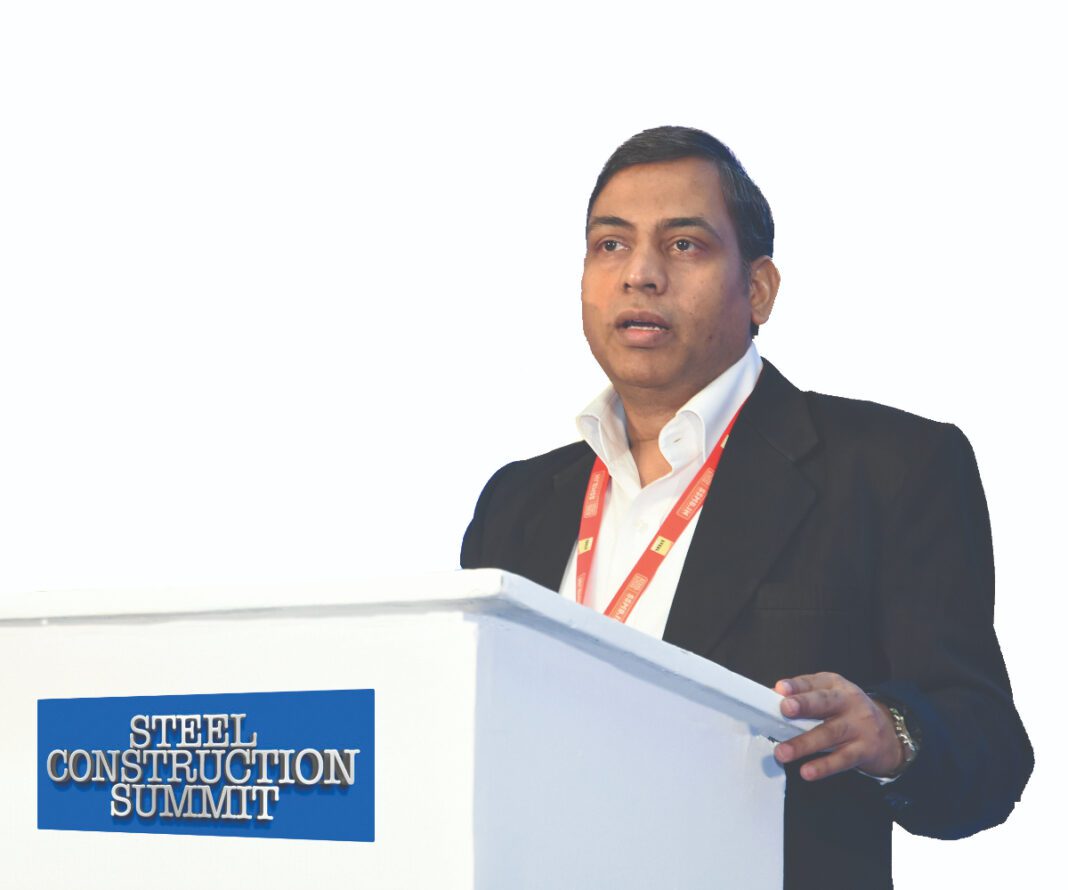What are some key government initiatives aimed at promoting the steel industry and enhancing its competitiveness, both domestically and globally?
The Government of India came out with National Steel Policy in 2017 which sets an ambitious target of 300 million tonnes domestic steel production capacity by 2030. As of date, we are at 175 million tonnes of installed capacity. Therefore, in the next six years or so, we expect an addition of around 120-125 million tonnes steel production capacity in India.
The Minister of Steel came out with the Steel Scrap Recycling Policy, which provides a framework to facilitate and promote the establishment of steel scrapping centres and the recycling of ferrous scraps. The Government of India is also implementing a Productivity Linked Incentive (PLI) Scheme for Specialty Steel with a broader vision of Atma Nirbhar Bharat. Under this, 57 MOUs with 27 companies have been signed. We expect Rs 29,500 crore investment by 2027-28 in the steel sector which will help create an additional capacity of 25 million tonnes in this category. There are various other initiatives of the Ministry of Steel. The primary goal of these policies and initiatives is to enhance the domestic steel industry’s robustness and global competitiveness by advancing to higher quality standards and improved technology.
How do you perceive the role of public-private partnerships (PPP) in fostering the growth of the steel industry and supporting infrastructure development projects in India?
The National Infrastructure Pipeline (NIP) has envisaged an investment requirement of Rs 100 trillion in the infrastructure sector in five years. That’s a huge investment requirement. So, to finance this massive investment requirement in the infrastructure sector, budgetary grants will need to be supplemented by extra-budgetary sources. Public Private Partnership (PPP) is an important tool when it comes to mobilising private sector finances for investment in the infrastructure sector while also setting ourselves a target of becoming Viksit Bharat by 2047. It also brings to the table the efficient project management practices that the private sector is known for. It is a mixed bag – we have had several success stories with PPP in infrastructure, but there have also been some not-so-successful projects undertaken on PPP mode.
The key point in PPP projects is the design of contracts. The concession agreements must allocate the risks and responsibilities appropriately between the public partner and the private partner. There have been some instances where PPP projects have led to some litigations and renegotiations, during the execution phase, which sets back the concerned project by several years in some cases.
We already have model concession agreements for sectors such as highways and airports, but if we can have a model concession agreement for other sectors like water supply in urban areas, it will help in promoting PPP projects in the infrastructure sector in an efficient way in the future.
Can you discuss any recent policy interventions or regulatory reforms aimed at addressing challenges faced by the steel industry, such as the CBAM?
The Government is mindful of the need for decarbonisation of the steel sector. In the context of Green Steel, the Ministry of Steel has set up 14 task forces to deliberate upon the various dimensions of Green Steel. It ranges from the taxonomy of Green Steel to resource efficiency to more sophisticated subjects, like carbon capture utilisation & storage, etc.
The Government is in the process of finalising and coming up with a consolidated report on Green Steel, which will provide a roadmap for future course of action in the steel sector. We are mindful of the fact that environmental laws are increasingly being used as a trade-restrictive measure. An example is the EU’s Carbon Border Adjustment Mechanism (CBAM). So, if we have to be globally competitive, our domestic steel industry has to shift towards low-carbon intensive steel manufacturing, which is going to be an important aspect in future. The Government is also mindful of possibilities of imports of substandard steel or low-quality steel to India. Therefore, the Ministry of Steel issues quality control orders to prohibit imports of substandard steel products in India.
How do you foresee the future trajectory of the steel industry in India, considering factors such as technological innovation, global market dynamics, and evolving consumer preferences?
When we examine the global scenario, India is clearly a bright spot. Currently, the Indian steel industry is still expanding, whereas many other countries are facing a situation where the demand for steel and its consumption is stagnant. There is a strong interlinkage between the steel Industry and GDP. At present, we are the fastest-growing major economy in the world. With the kind of GDP growth that the Indian economy is expected to experience in the medium to long run and continued emphasis on infrastructure, we expect sustained high level of growth in demand for steel in medium to long run. Steel also has several multiplier effects, not just in terms of economic output but also employment. Therefore, I think we are in a position where the Indian steel industry is the most shining example in the global perspective in terms of the growth prospects and robust domestic demand that the Indian economy provides to the Indian Steel Industry.
Moreover, the Indian steel industry has been largely focused on meeting domestic demands. Indian steel industry does not face any serious demand side risk.
Developments in the domain of Industry 4.0 and AI has been rapid in recent years. We will see an increased application of recent technological advances in the steel industry as well. In the context of Green Steel, we expect to witness an increased shift towards using cleaner fuels such as Green Hydrogen. Some Indian companies have already started working on the same, and we can expect a transition towards a low-carbon steel industry in the next five years or so.
In your opinion, what role can the steel industry play in supporting India’s ambitious infrastructure projects such as Smart Cities, Bharatmala, Sagarmala, and Make in India?
We can add many other ambitious schemes to this list such as the Jal Jeevan Mission and Metro Rail projects in various cities of India. Clearly, steel is a critical input in such infrastructure projects and sectors, as well as construction. The success of these ambitious schemes, in a sense, also depends on how the industry ramps up its production to meet the increasing demand emanating out of various infrastructure projects under the ambitious flagship schemes of the Government of India.
In my opinion, the steel industry needs to see itself as a key provider of sustainable infrastructure. There are geographical diversities in India; for example, some parts of India are in high seismic zones and we also have a vast coastline of around 7,000 km, where corrosion resistant infrastructure is the need of the hour. In several other contexts, it will be desirable to have a more steel intensive structure in place.
Given your involvement in various ministries and your expertise in economic policy formulation, how do you envision synergies between different sectors to achieve holistic and sustainable growth objectives for the nation?
Sustainable development entails ensuring that our development journey does not compromise the development opportunities and prospects of future generations. The durability and resilience of steel intensive structures are also going to be important for sustainable development. And if, as I have already mentioned, our transition towards low-carbon steel materialises, it will also help us in improving the carbon footprint of our entire development process.
If we look at various dimensions of sustainability, steel checks almost all the boxes. Sectors like transportation, especially railways and civil aviation, are inherently more steel-intensive, with airports relying heavily on steel structures. These sectors have seen expansion in the recent past years. Moving forward, we anticipate the expansion of various transportation sectors. As people are increasingly traveling across different parts of the country, the demand for transportation services has increased significantly.
Our country is rapidly urbanising. Cities have emerged as hubs of economic activities. Indian cities are heterogenous, presenting a diverse range of sizes, and developmental stages. Major metropolitan centres like Mumbai, Delhi, and Bangalore are vibrant, while thousands of smaller cities are also expanding and experiencing their own development paths.
The Government of India through the Ministry of Housing and Urban Affairs is implementing ambitious schemes for addressing the development needs of Indian cities. These schemes include Smart Cities Mission, Swachh Bharat Mission Urban, Pradhan Mantri Awas Yojana Urban, Jal Jeevan Mission and Atal Mission for Rejuvenation and Urban Transformation.
The aspirations of city dwellers are also significant. So, while examining the need to cater to them, we shall move beyond the basic needs to an aspirational aspect of this development process. I also think that inherently these are all construction and infrastructure sectors. Therefore, steel plays a major role in this entire schema of development process.
It is important for the Indian steel industry to ramp up production to meet the increasing demand, ensuring high-quality steel that caters to the specific needs of different regions across India. It will also be important for the steel sector to move towards cost optimisation so that India’s development process is at a low-cost trajectory.





